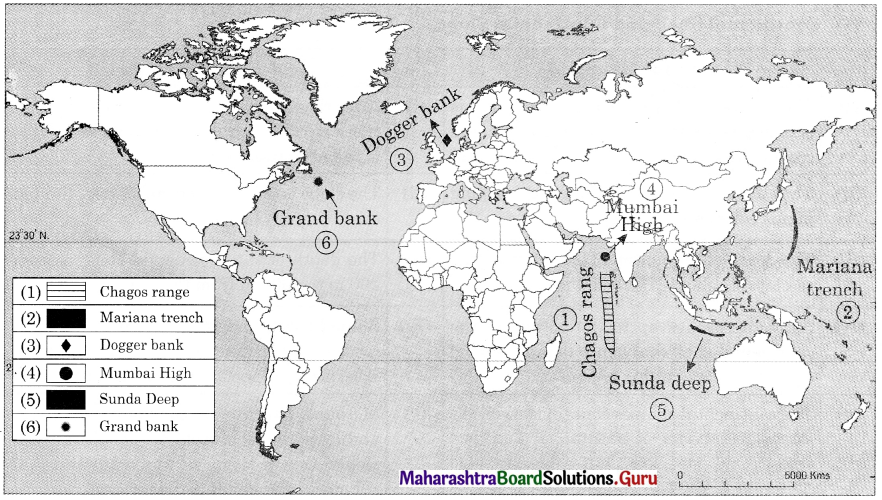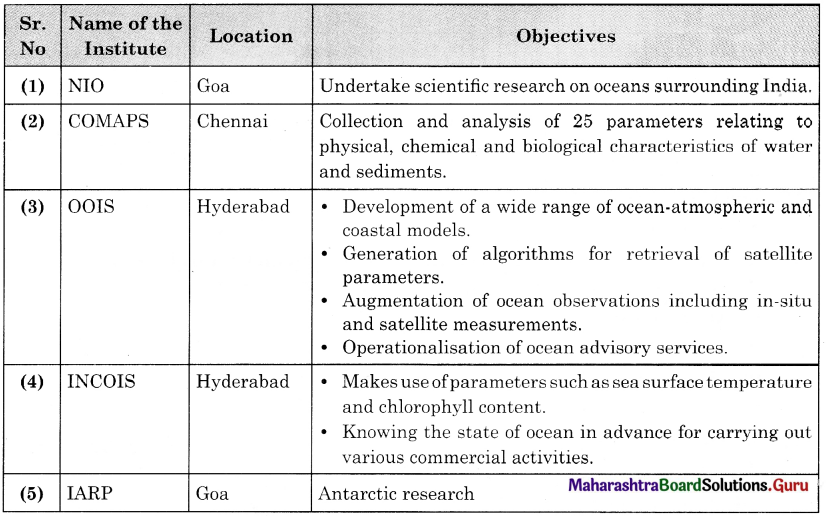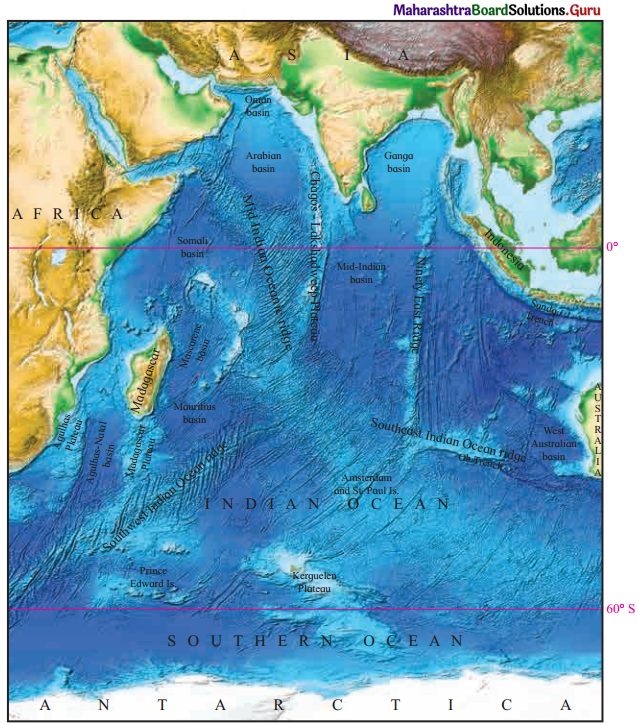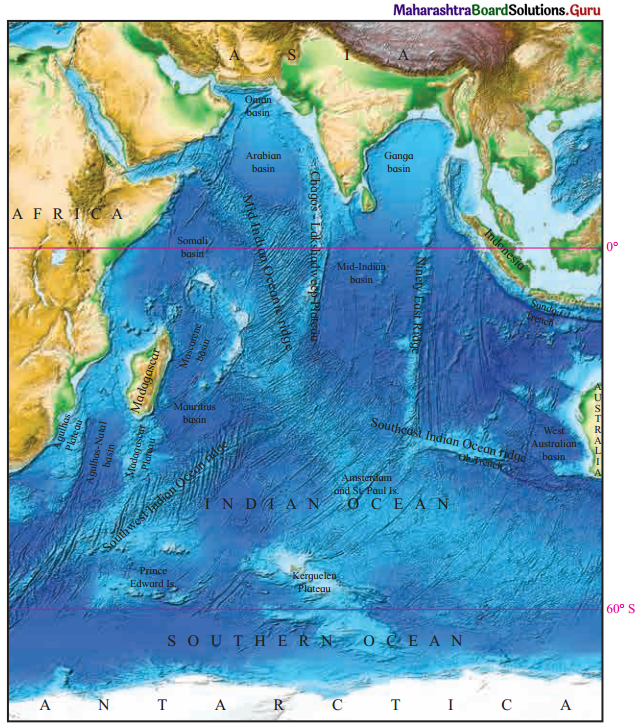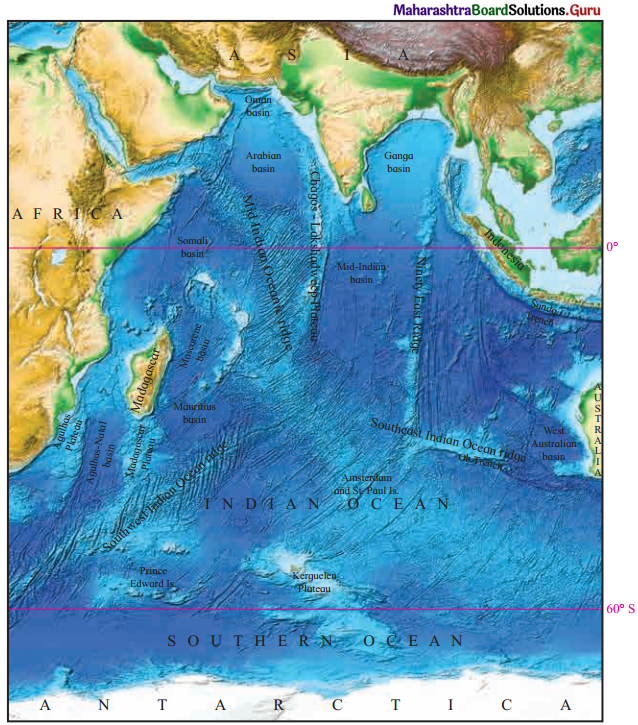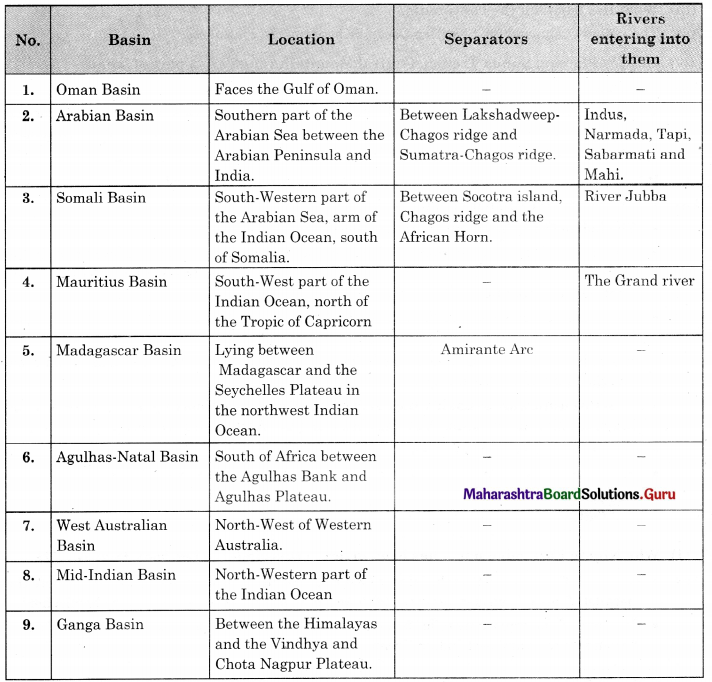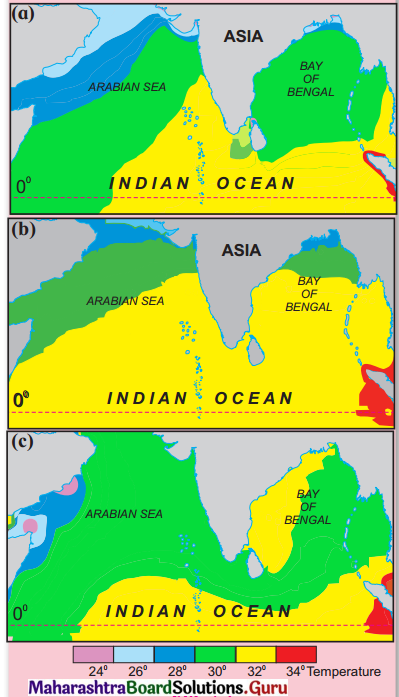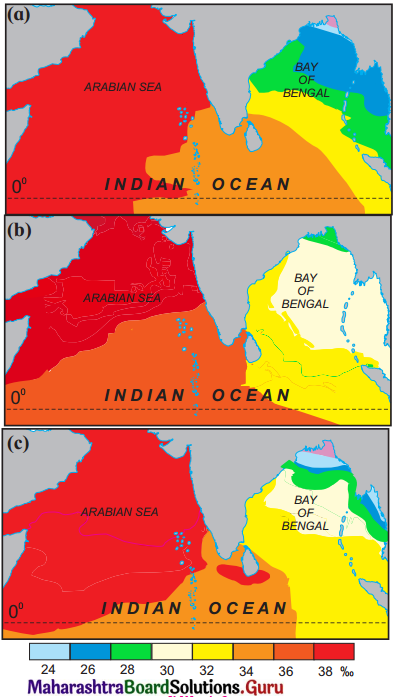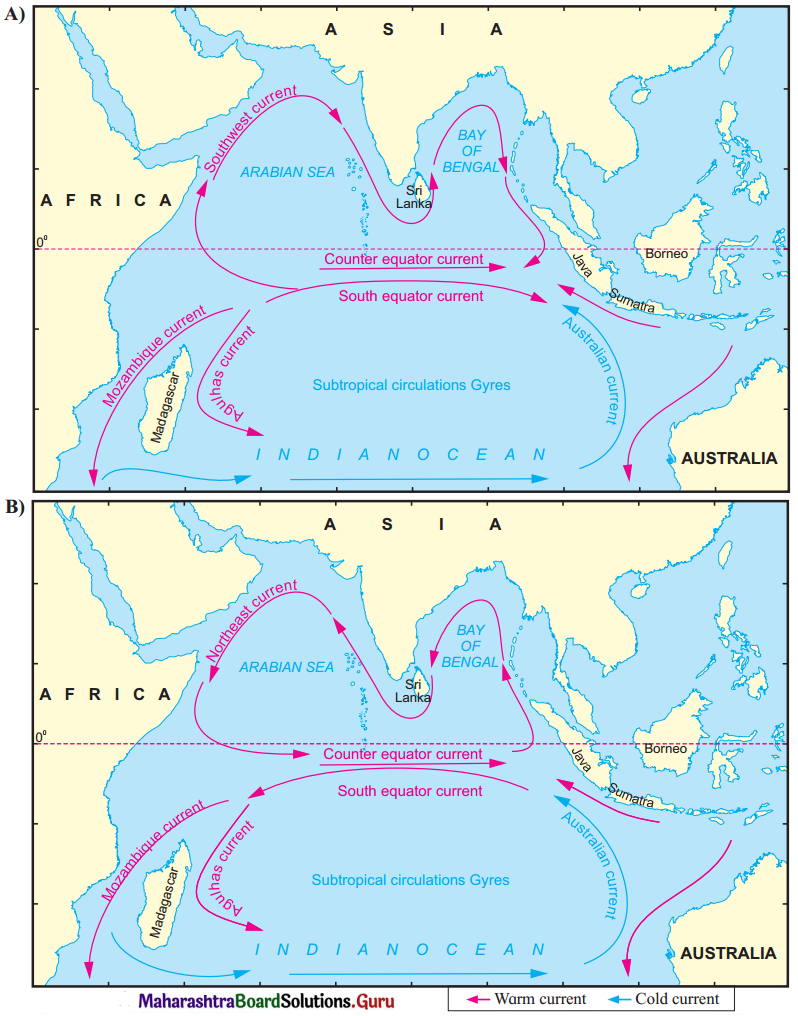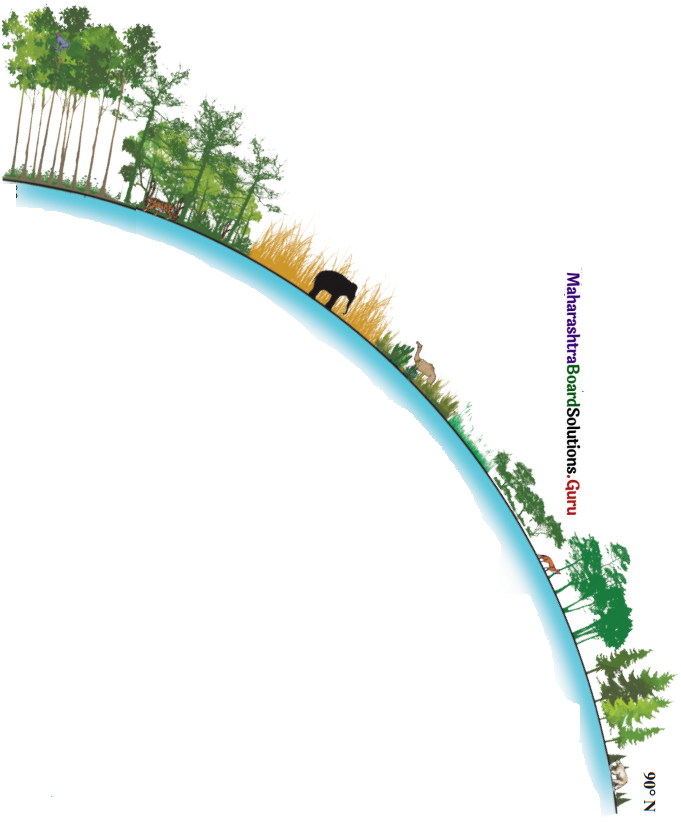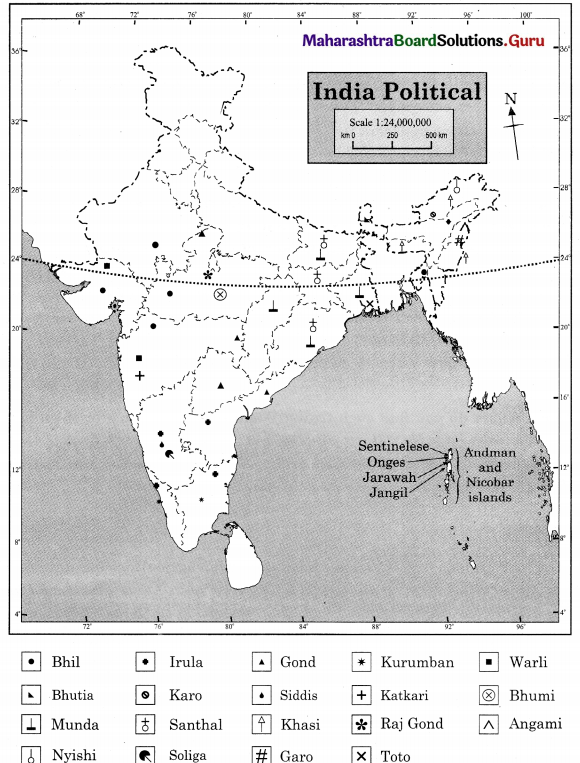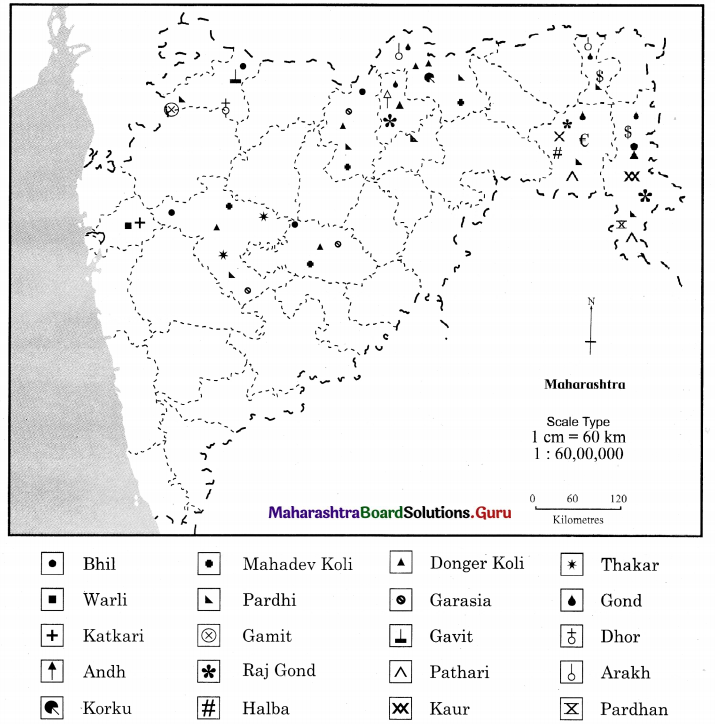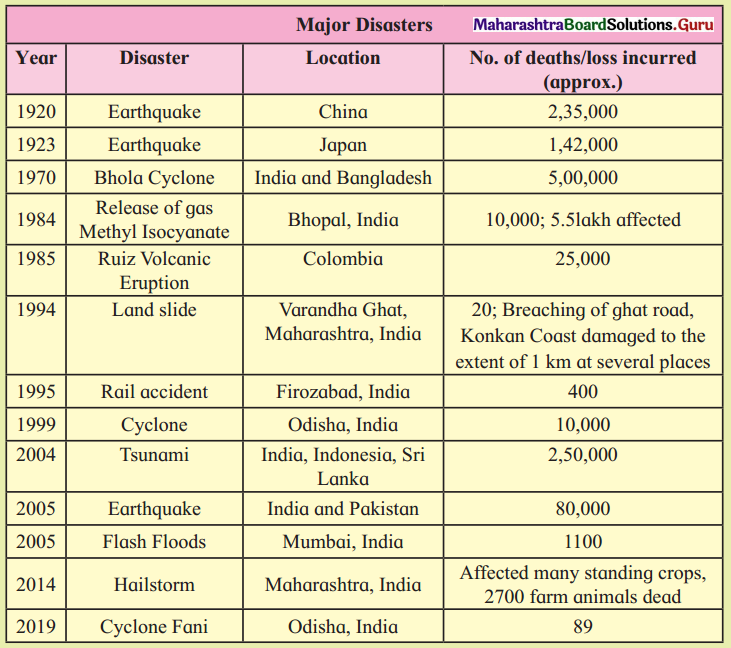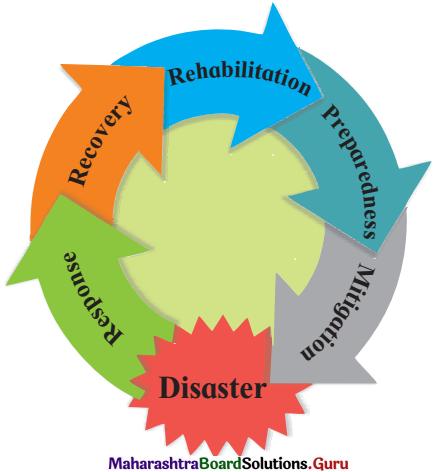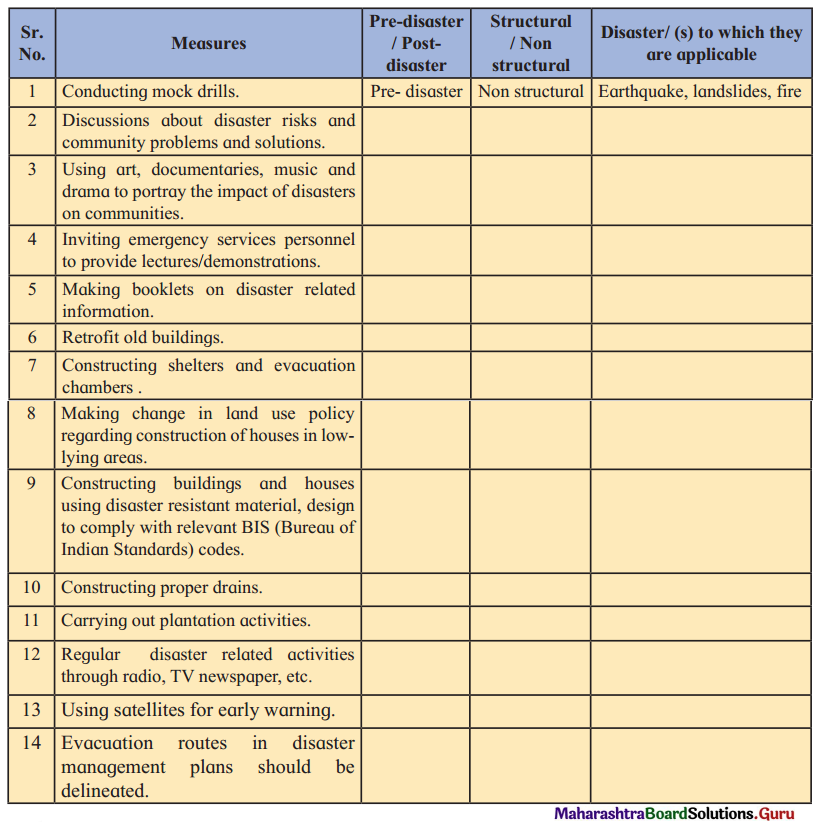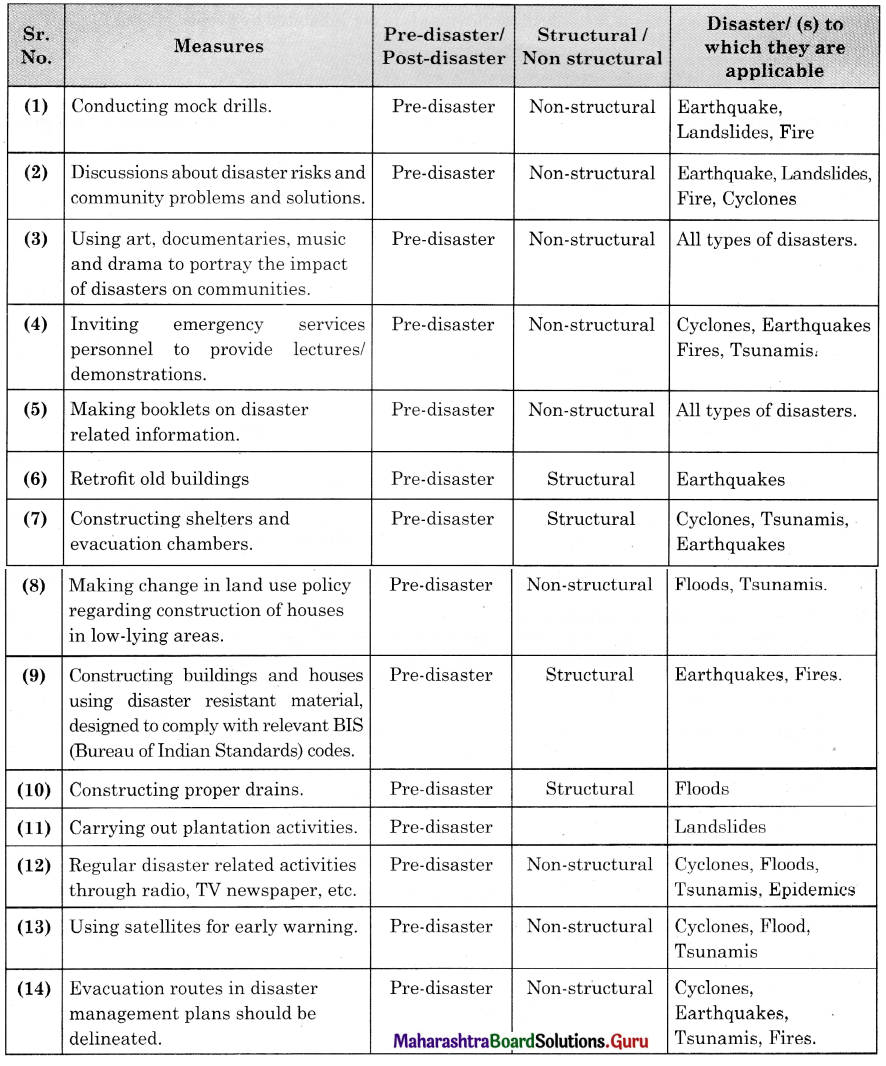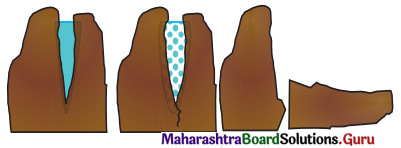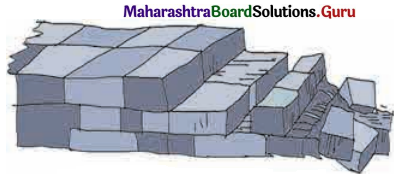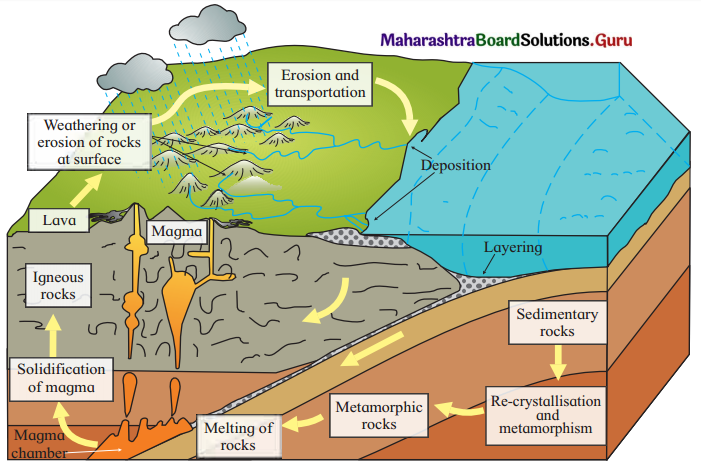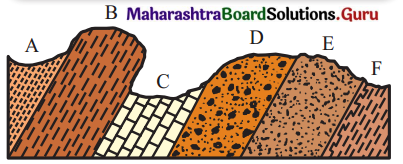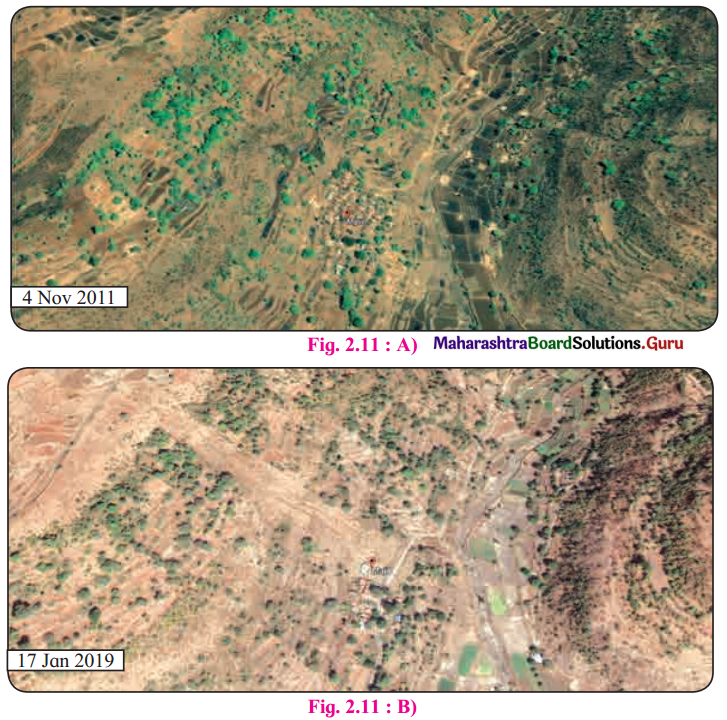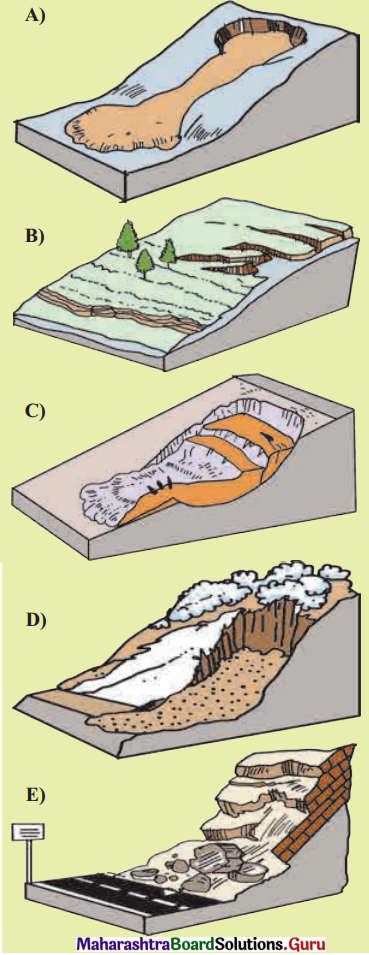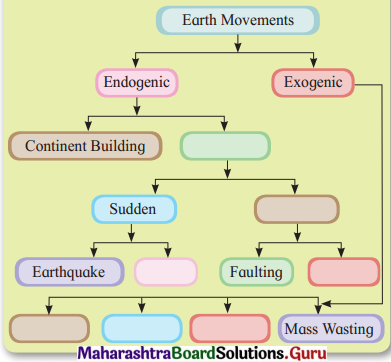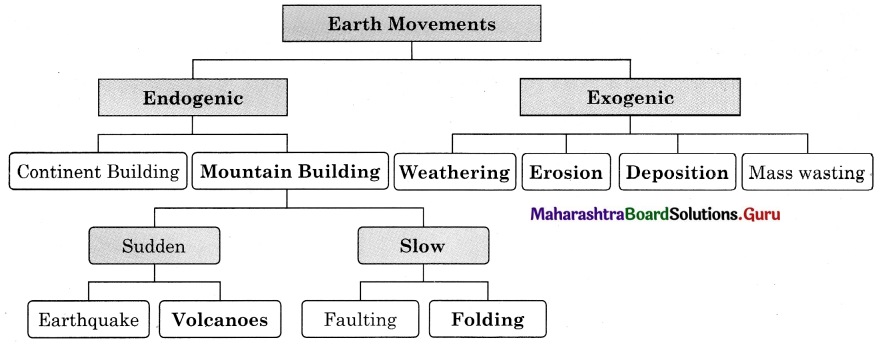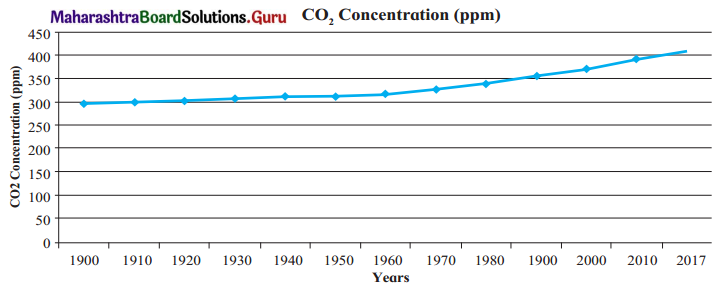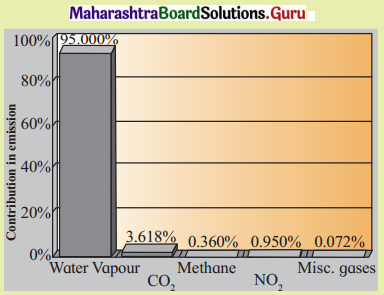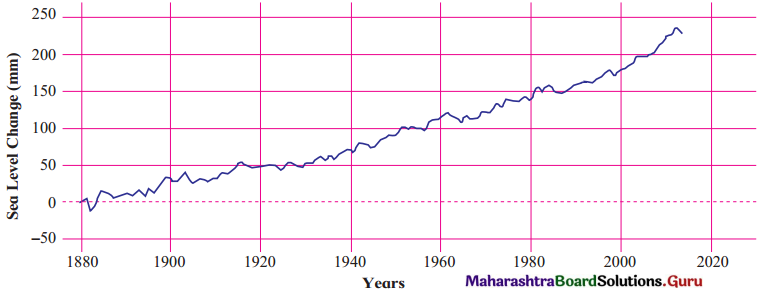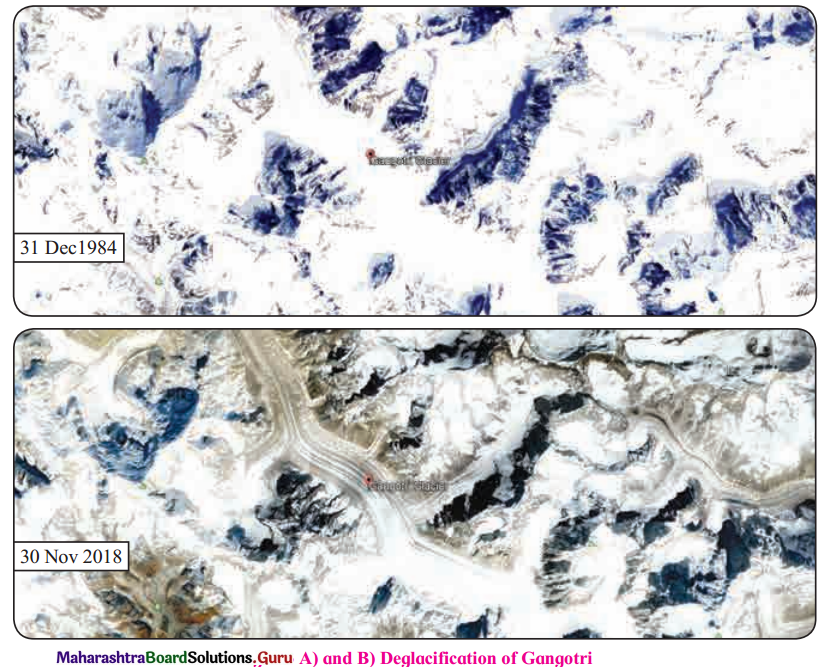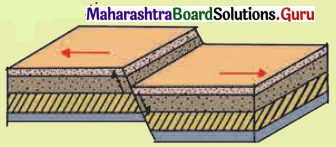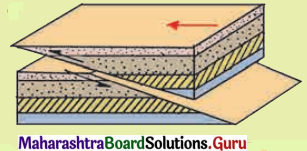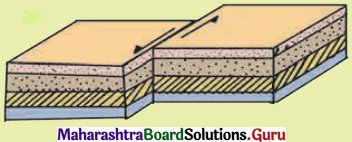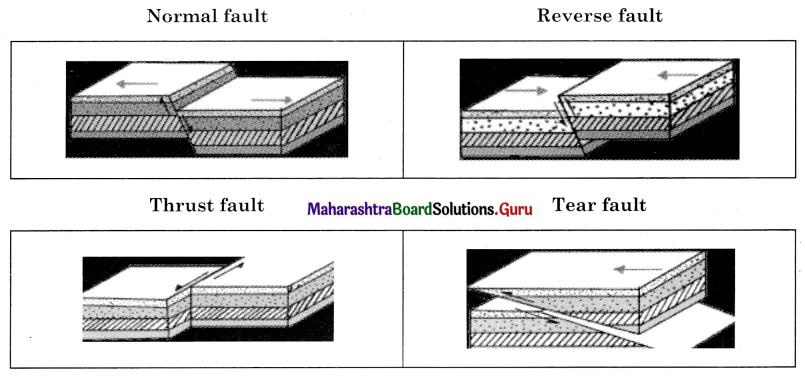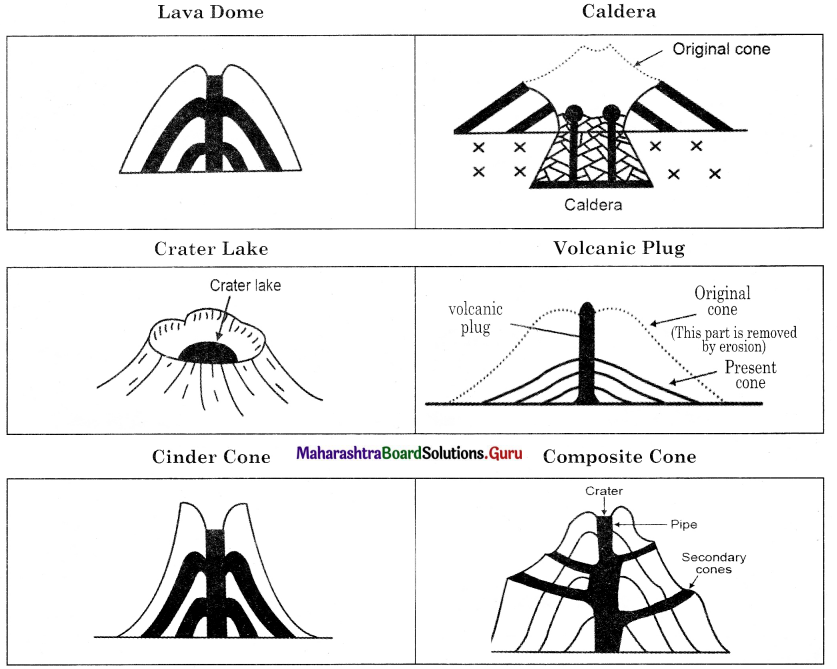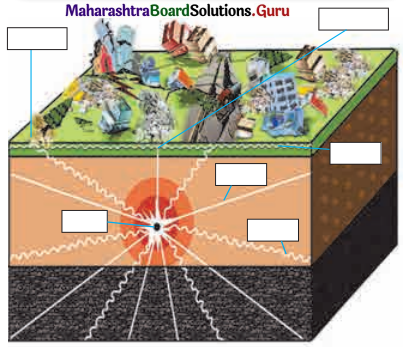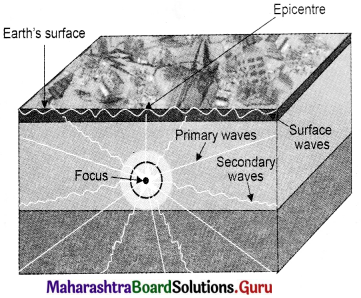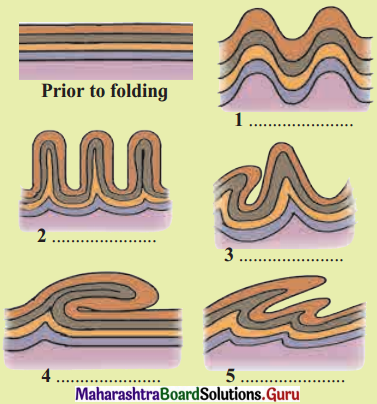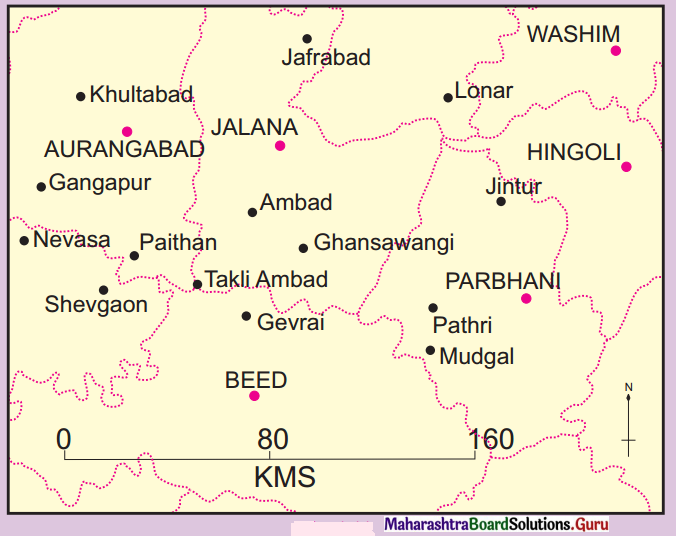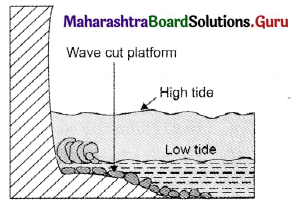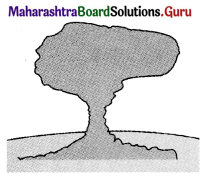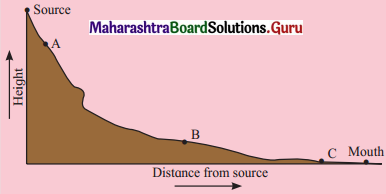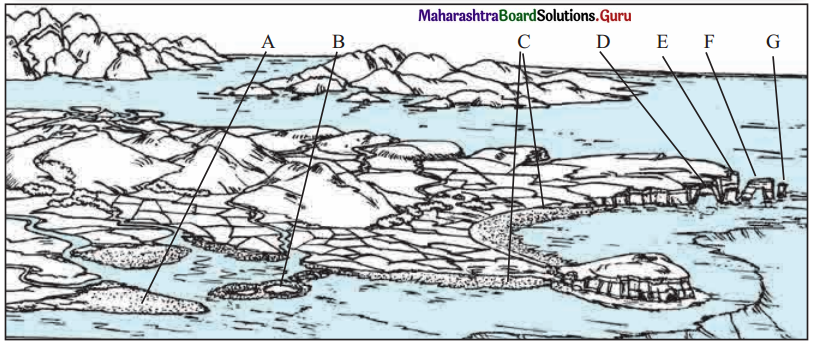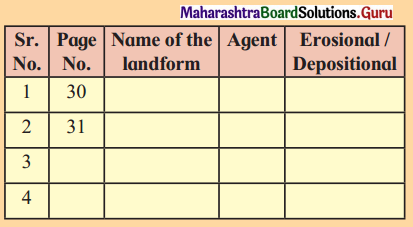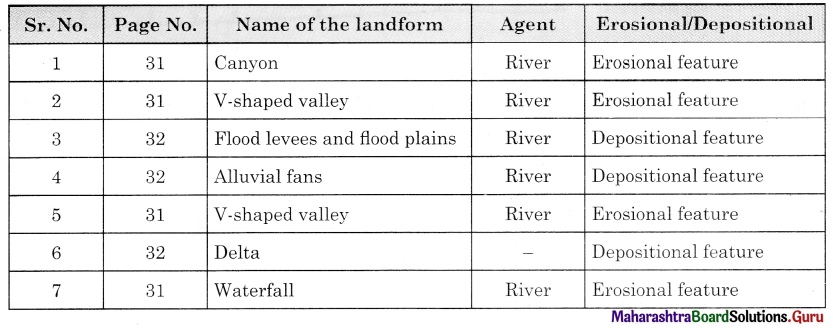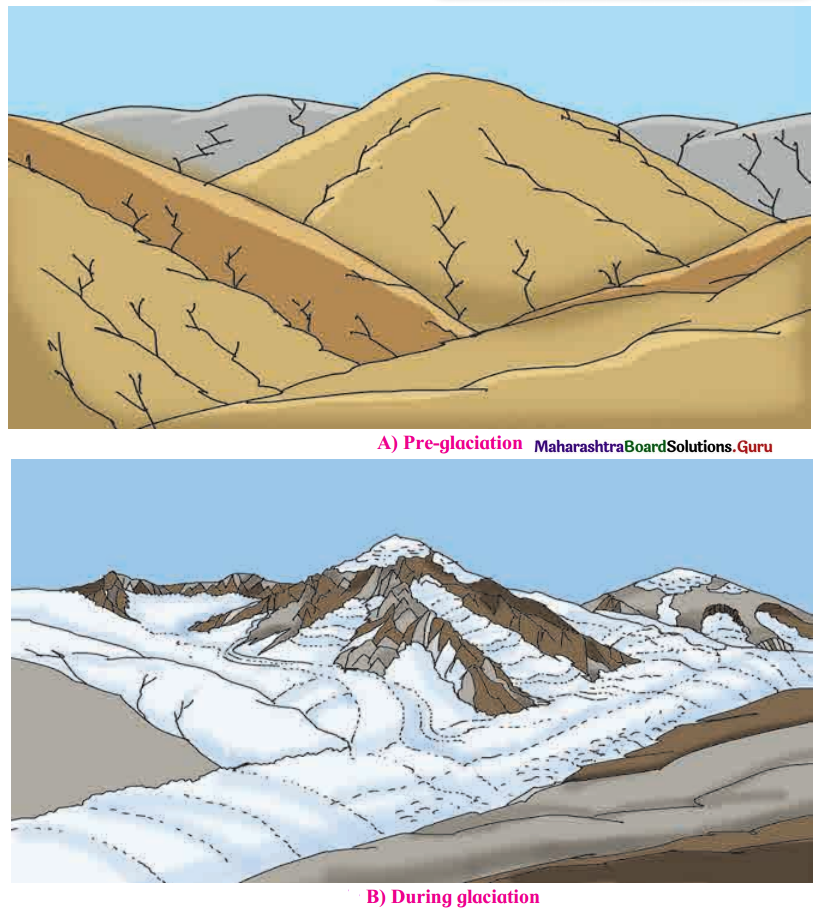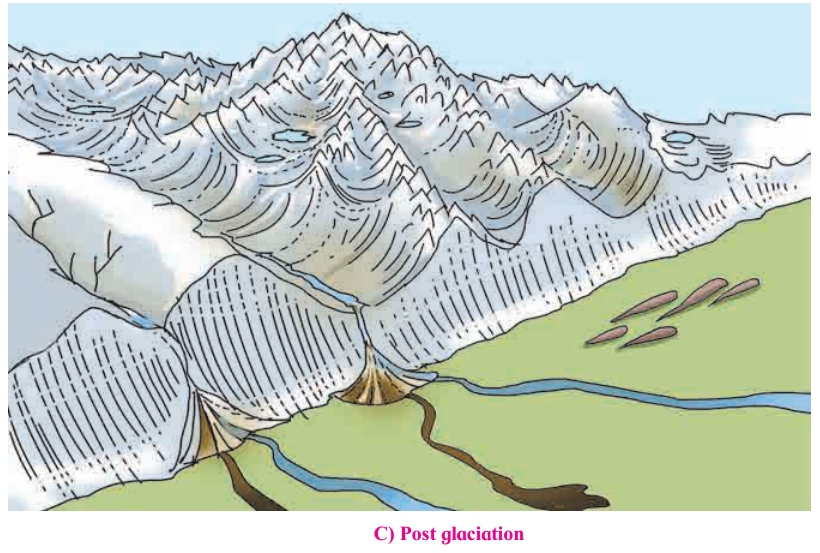Balbharti Maharashtra State Board Class 11 Geography Solutions Chapter 4 Climatic Regions Textbook Exercise Questions and Answers.
Maharashtra State Board Class 11 Geography Solutions Chapter 4 Climatic Regions
1. Write the names of climatic regions according to the factors that dominate their characteristics.

Answer:
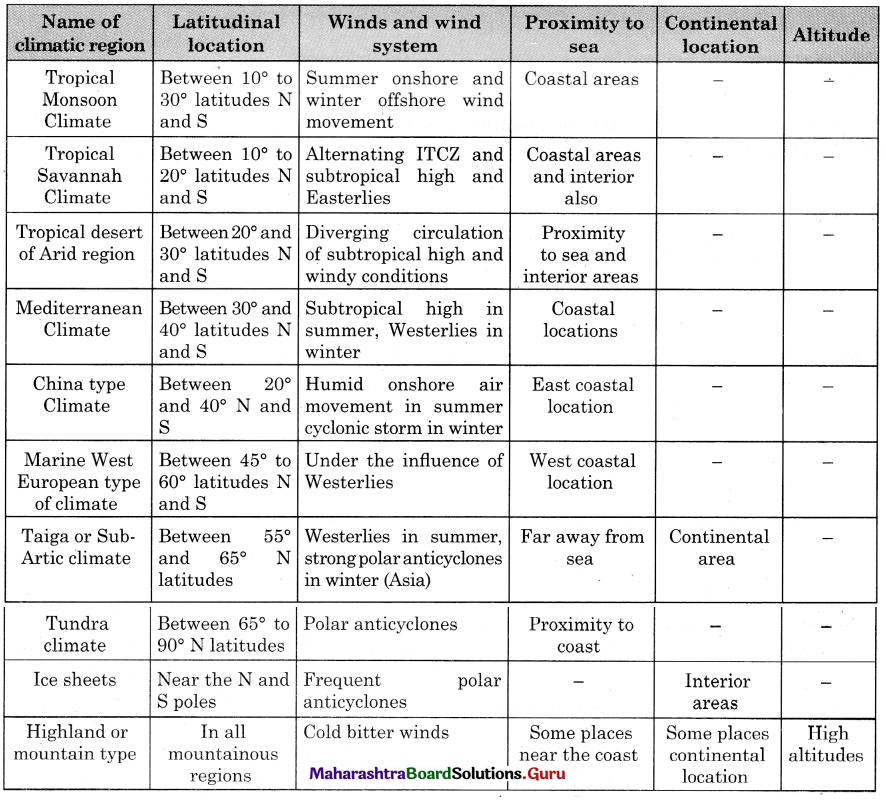
![]()
2. Choose the correct alternative
Question 1.
Monsoon region
(a) annual average temperature around 27° C
>2500 mm annual precipitation
Indonesia
Hard-wood evergreen trees
(b) Average temperature in Summers around 35° C
< 2500 mm annual rainfall
South East Asia
Hard wood deciduous trees
(c) Temperatures in summer around 35° C
1000 mm annual rainfall
Continental part of Indian peninsula
Tall and thick grass
(d) Average temperatures in summer around 27° C
1000 mm rainfall in winter
South Africa
Hard–wooded, waxy, evergreen forests
Answer:
(b) Average temperature in Summers around 35° C
< 2500 mm annual rainfall
South East Asia
Hard wood deciduous trees
![]()
Question 2.
The region with high diurnal range of temperature
(a) Tropical rainforests
(b) Tropical grasslands
(c) Tropical desert regions
(d) Tropical Monsoon regions
Answer:
(c) Tropical desert regions
Question 3.
Lumbering flourished as an occupation from Newfoundland to Alaska in North America because
(a) Tundra Climatic Region
(b) Taiga Climatic Region
(c) West European Climatic Region
(d) China-type climatic region
Answer:
(b) Taiga Climatic Region
Question 4.
The main reason behind the months of precipitation in the graphs of Monsoon climatic regions being different is
(a) ITCZ
(b) orographic rainfall
(c) hemispheres are different
(d) apparent movement of the sun
Answer:
(a) ITCZ
3. Give geographical reasons.
Question 1.
In monsoon climate region, rainfall occurs in specific season.
Answer:
In monsoon climate region, rainfall occurs in specific season because-
- The differential heating and cooling of land and water creates low pressure on the land while the sea experiences high pressure.
- This is strongly related to shifting of the ITCZ. During the summer the ITCZ moves north to the latitudes of 20°-25°.
- Several months later, the moisture laden summer monsoon is replaced by dry north-east monsoon.
- By this time, the ITCZ has shifted to the southern hemisphere.
- In northern hemisphere, the winds move from sea to land bringing moisture along with them in summers and gives rainfall.
- In southern hemisphere same conditions prevail when there are winters in the northern hemisphere.
![]()
Question 2.
Taiga region is not found in Southern Hemisphere.
Answer:
Taiga region is not found in Southern Hemisphere because-
- There is not much land at higher altitude in the southern hemisphere (until inside the Antarctic circle) where it is permanently ice covered.
- Most of the land is fairly close to oceans and thus tempered by marine warming.
- Whereas, Taiga is found throughout the high Northern latitudes between Tundra and the temperate forest, characterised by coniferous forests.
- The strong oceanic influence in the southern hemisphere reduces the severity of the winter, thus, affecting the temperature and precipitation.
Question 3.
The diurnal range of temperature is more in desert areas.
Answer:
The diurnal range of temperature is more in desert areas because-
- Deserts get hot during the day, but cool down rapidly during night. The main reasons for the temperature fluctuation between day and night are the lack of humidity and cloud cover.
- Because of water’s relatively high specific heat, humid air takes longer to warm or cool, while air on land warms or cools more quickly.
- Because desert areas receive a large amount of sunlight, the temperatures can get very high, but during night the dry air cools quickly.
- The lack of cloud cover overhead allows the warmer air to rise into the atmosphere while cooler air settles in its place.
- Basically, desert temperature varies so much because there is less moisture and cloud to keep the heat there.
Question 4.
There is no concept of season in equatorial regions.
Answer:
There is no concept of season in equatorial regions because-
- The equatorial region lies between 0° to 10° latitudes in both the hemispheres.
- The sun is exactly overhead in the equatorial regions throughout the year giving maximum insolation.
- Thus, constant high temperatures are experienced throughout the year, which gives rise to heavy convectional precipitation.
- Days and nights are almost of equal length and thus, the concept of summer and winter as being hot and cold seasons do not exist in these parts.
Question 5.
The Savannah region is prone to droughts.
Answer:
The Savannah region is prone to droughts because-
- The region lies between 10° to 20° N and S latitudes, where the sun’s rays at noon are never far from overhead and thus the insolation is maximum and temperature is constantly high here.
- Distinct wet and dry seasons of relatively equal duration are found. Most of the regions annual rainfall is experienced during the wet season and very little precipitation falls during the dry season.
- A lengthy dry season and a relatively short wet season is the characteristic of Savannah region.
- Thus, in Savannah region the dry season becomes more severe and often drought conditions prevail during the course of the year.
![]()
Question 6.
Though Mussoorie and Dehradun are located on the same latitude, why is their climate different?
Answer:
Though Mussoorie and Dehradun are located on the same latitude, their climate is different because-
- Dehradun lies in the humid sub-tropical climatic region where the summers are long, hot and humid. Whereas, Mussoorie is a hill station in Dehradun district of Uttarakhand which lies in sub-tropical climatic regions that are very wet.
- Dehradun lies at an elevation of average 450 m above mean sea level whereas Mussoorie is at an elevations of 1880 m above mean sea level.
- In Dehradun during monsoon season there is often heavy and protracted rainfall, whereas in Mussoorie an average of 660 mm orographic rainfall is experienced.
- The winter temperature is around 1°C and 20°C in Dehradun with fog commonly experienced. Mussoorie usually receives few spells of snowfall in December, January and February.
4. Differentiate between.
Question 1.
Equatorial Rainforests and Savannah Climatic Regions.
Answer:
| Equatorial Rainforests | Savannah Climatic Regions | |
| Latitudinal extent | It lies between 0° to 10° latitudes in both the hemispheres. | It lies between 10° to 20° latitudes N and S. |
| Temperature | As it lies near the equators sun rays are perpendicular and hence temperature is constantly high with average temperature around 27°C. | Distinct wet summers and dry winters with summer temperatures around 35°C and winter temperature around 24°C. |
| Rainfall | Heavy convectional rainfall of 2500 mm to 3000 mm is evenly distributed over the year. | In this region average rainfall of 250 mm to 1000 mm is expected. |
| Vegetation | Evergreen trees with dense three layered vegetation are found in rainforests. | Tall thick grass (Elephant grass) with scattered drought-resistant trees are found in this region. |
| Animals | Climbing and jumping animals, reptiles, etc., are found in this region. | Grazing of animals is common. Herbivorous, carnivorous and scavengers are found in this region. |
| Regions of the world | This type of climate is found in the Amazon basin, Congo basin, east coast of Central America, Madagascar, Malaysia, Indonesia, Philippines and Papua New Guinea. | This type of climate is found in India in peninsular plateau and rain-shadow zone in Maharashtra, Telangana and Karnataka; parts of Mizoram. It is also found along borders of Congo, South Central Africa, llanos of Venezuela, Campos of Brazil, etc. |
Question 2.
Taiga Region and Tundra Region.
Answer:
| Taiga Region | Tundra Region | |
| Latitudinal extent | Taiga region is found between 55° to 65° North latitude. | Tundra region is found between 65° to 90° North latitude. |
| Temperature (Summer) | Brief cool summers with temperature around 15°C to 20° C. | Summer temperature is aroundl0°C. |
| Temperature (Winter) | Bitterly cold winters with temperature less than 0°C is found in this region. | Winter temperature is around -20°C to -30°C. |
| Precipitation | Year-round precipitation is around 300 to 500 mm in summers, snowfall in winters. | Precipitation is in form of snow around 300 to 500 mm. |
| Other Atmospheric phenomenon | Heavy cloud cover, high humidity, drizzle, fog, frost, cold winter poleward are the characteristics of Taiga region. | Low evaporation, coastal fog are the characteristics of Tundra region. |
| Location | Continental location. | Proximity to coasts. |
| Vegetation | Coniferous forest with soft wood, vegetables and root crops are found. | Tundra vegetation, swamps during melting is formed. |
| Animal life | Animals with fur like moose, foxes, bear, etc., are found. | Animals with fur like polar bear, seal, walrus are found. |
| Human occupation | Hunting and lumbering is the major occupation. | Hunting and fishing is the major occupation. |
| Regions of the world | Northern part of North America from Newfoundland to Alaska, northern Eurasia from Scandinavia through most of Siberia to the Bering Sea and Sea of Okhotsk are the major regions where Taiga region is found. | Arctic ocean borderlands of North America, Greenland and Eurasia, Antarctic, Peninsula, some polar islands are the major regions under Tundra vegetation. |
![]()
Question 3.
Monsoon and Mediterranean Regions.
Answer:
| Monsoon Region | Mediterranean Region | |
| Latitudinal extent | Within 10° to 30° North and South of equator. | Western coastal region between 30° to 40° North and South. |
| Temperature | Summer temperature is around 27°C to 32°C while winter temperature is 15°C to 24°C. High annual range of temperature. | Summers are warm and dry and temperature is around 21°C to 27°C while winters are mild and moist and temperature is around 10°C to 14°C. |
| Rainfall | Rainfall is between 250 to 2500 mm, excessively wet during rainy season. | Rainfall is around 500 to 1000 mm in winter. |
| Vegetation | Tropical rainforest, ranges from jungle to thorn forest in drier boundaries. | Scrub, forests have leaves evergreen, hard, thick leathery and small. Coniferous vegetation on higher altitudes and grass in areas of low rainfall is found. Winter- sown grains, olives, grapes, vegetables, citrus fruits are found. |
| Human Life | Agriculture is the main occupation of people of monsoon region. | Development of tourism and cinema industry. |
| Regions of the world | Coastal areas of South West India and South East Asia, South West Africa, North East and South East Brazil, Northern part of Australia and parts of Japan come under the monsoon winds. | Central California, borders of Mediterranean Sea, Cape Town (South Africa), Southern and South West Australia, Central part of Chile are the major region under Mediterranean climate. |
5. Answer in detail.
Question 1.
Explain, with examples, the effects of latitude on a place’s climate.
Answer:
Latitudes affect the climate of a place in different ways-
Places close to the equator receive more sunlight:
- The equatorial region lying between 0° to 5° North and South latitudes receive maximum heat as the sunrays are directly falling on the equator.
- Due to which the region receives heavy rainfall throughout the year.
- As a result, evergreen forests are found is such regions.
- Example : Amazon basin.
Places close to the tropical region receives less sunlight:
- Temperature gradually decreases with increasing distance from the equator, as the angle of sun’s rays decreases from it.
- In tropical areas the sun rays become slanting and thus it gives less heat but covers more area.
- Example regions lying between Tropic of Cancer 231/2°N to Tropic of Capricorn 23/4°S. Similarly, in the temperate regions 66X/20N and S and the polar regions the climate become extremely cool as the intensity of heat decreases. These regions are thus covered by snow.
Question 2.
Explain with examples, how winds affect the climate of a place.
Answer:
- The winds affect the climate because they create the hot and cold air which moves around.
- Prevailing winds affect the climate of an area. The direction of local winds is determined by the daily temperature of variations.
- When winds blow from warm areas, they carry higher temperatures while winds blowing from cold areas carry lower temperatures.
- Thus, winds bring in heat/ cold from the direction it has been blown from and thus changes the temperature of the place which affects the climate. For e.g., cold wind waves from the Himalayas carry coldness to the parts of the Deccan plateau.
- Winds that blow from the sea often carry moisture and give rain to the coast. For e.g.. south-west monsoon winds give heavy rainfall in the western coastline of India.
- Some winds are warm and dry, they increase the temperature during winter season. For example, winds that blow to Britain from warm areas such as Africa are warm and dry. Such warm and dry winds increase the summer temperature in some areas.
![]()
Question 3.
Russia is larger than Chile in area but does not experience climatic diversity as Chile. Explain.
Answer:
- The latitude and longitude of Russia is 61.5240°N and 105.3188°E respectively. It is located in northern Asia, between Europe on one side and North Pacific Ocean on the other side.
- Chile is situated along western margin of South American continent. Its latitude and longitude are 35.6751°S and 71.5430°W respectively.
- Russia has continental location since it is surrounded to south and west by huge landmass, and to the north lies Arctic ocean which is frozen, so it is like snow covered land.
- Thus, due to continental location there are dry summer and very cold winters with temperatures of -30° and less and sometimes heavy snowfall.
- The winter is mostly dry, snow covers the ground from the end of October to mid-March.
- In Chile the coastal location and the east-west extent is very less.
- There is a lot of climatic diversity in Chile. There is Atacama Desert in the north, Mediterranean climate at the central part, extreme cold climate in the east.
- The most important factors that control the climate of Chile are Pacific anticyclone, cold Humboldt ocean current and mountain ranges along the coastline.
- Thus, though Russia is larger than Chile in area but does not experience climatic diversity as Chile.
Question 4.
Explain the factors affecting climate of a place giving examples.
Answer:

Latitude : Latitude is the primary factor influencing distribution of atmospheric temperature. Generally, latitudes of high degrees are less warm than the low degrees of latitudes. Thus, sun’s rays making a high angle to the ground, experience high temperature throughout the year. Temperature gradually decreases with increasing distance from the equator as the angle of the sun’s rays decreases away from it. Hence, the polar region experiences very low temperature.
Altitude : The atmosphere is indirectly heated by terrestrial radiation from surface of the earth. Therefore, the place near the sea level experiences higher temperature than the places situated at higher altitude. In other words, the temperature generally decreases with increase in height. The rate of decrease of temperature with increase in height is known as Normal Lapse rate. It is 6.4°C per 1000 meters altitude.
Distance from the Sea : The location of place with respect to the sea also determines the temperature of that place. Though, the sun provides same amount of heat over land and water bodies, there is difference in their heating and cooling capacity. Compared to land, the sea (water) gets heated slowly and loses heat slowly. On the other hand, land heats up and cools down faster. Therefore, the variation in temperature over the water bodies is less as compared to land masses. The coastal areas come under the moderating influence of the sea and land breezes and experience moderate or equable climate while interior parts of the continents experience extreme climate.
Prevailing winds : Winds affect the temperature and rainfall of any area. Winds carry with them the temperature of their source regions. Hot winds increase the temperature while cold winds decrease the temperature, e.g., cold wind waves from Himalayas carry low temperature to parts of the Deccan Plateau. Thus, south west monsoon winds in India reduce the temperature after the onset of monsoon in June all over the country.
Some winds carry moisture and give rain to the area they visit. For example, South-west monsoon winds give rainfall to western coastline of India.
Ocean currents : Ocean currents considerably influence temperature of the adjacent land area. Warm currents raise the temperature of the coastal areas, whereas cold currents reduce the temperature near the coast where they flow.
Aspect of slope : In the northern hemisphere the south facing slopes and in the southern hemisphere the north facing slopes always face the sun. Hence, sun facing slopes are warmer and the opposite slopes are cooler.
6. On a world map, show the following areas
(1) Equatorial Rainforests and Savannah Climatic Regions.
(1) Savannah climatic region in Africa
(2) Highland climatic region in India
(3) Chile and Russia
(4) Ice cap climatic region
(5) Desert
Answer:
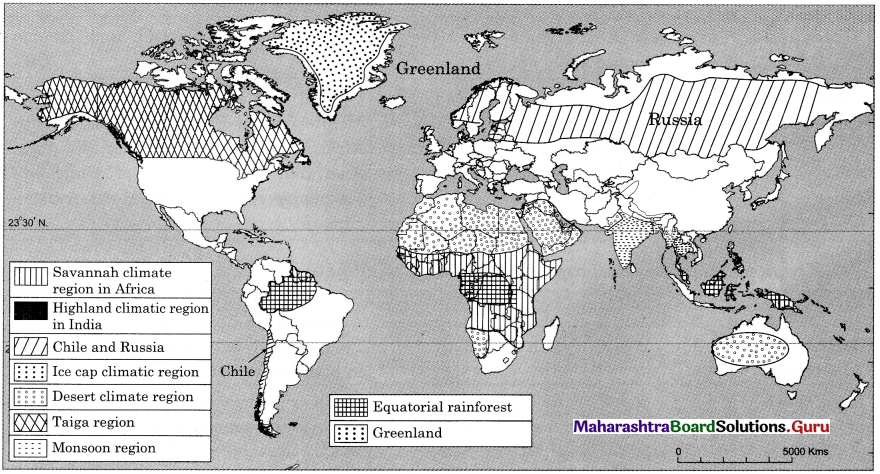
![]()
11th Geography Digest Chapter 4 Climatic Regions Intext Questions and Answers
Use vour brain power!
Question 1.
(i) Have you ever thought why there is difference in the skin colour of various people in the world?
(ii) Why all the people in the world do not eat same food?
(iii) Why there is a variety in clothing pattern and types too? Even our houses are different.
(iv) How come flora and fauna are restricted to a particular region?
(v) Why different fruits are found in different places? (Textbook Page No. 44)
Answer:
(i) There is variation in skin colour of people depending on the latitudes. For. e.g., people near the equator are dark since the sunrays are vertical and hence there is too much heat, while people in temperate or polar region are fair since sunrays in these regions are slanting due to increase in distance from sun. Hence, there is low temperature and colour of skin is fair.
(ii) There is variation in food because food depends on geographical factors like climate, soil, location etc. For example, in extreme cold climate areas soil is covered with snow, so agriculture is not possible, people eat fish and meat of fur bearing animals. The countries located along the coastline eat fish and rice because fishing is carried out at the coastal areas and rice is grown on fertile delta of the river along the coastline.
(iii) People prefer to use clothes according to climate. For example, Inuits in Polar region wear fur clothes due to extreme cold climate, Europeans wear woollen cloths in winter due to cold climate, Asians mostly wear cotton clothes except in winter.
The pattern of house depends upon the climate and availability of material in the surrounding area. For example, in heavy rainfall areas houses have sloping roofs, in hot climatic areas houses are made up of stones or thick walls to prevent the effect of outside hot air.
People use material available in the surrounding area for construction of houses. For example, Inuits in Polar region use snow to build houses, since it is available in plenty. These peculiar houses are called Igloos.
(iv) Particular temperature and rainfall are essential for the growth of flora. For example, coniferous forest grows in cool climate and snowfall. Flora provides food and shelter to fauna, therefore wherever there is thick flora, fauna is bound to be there. In grassland region grass eating animals like dear, antelope, rabbits are seen but the camel is seen only in the desert.
(v) Every fruit crop requires particular type of climate; therefore, different fruits grow in different areas depending upon the climate. For example, apples are grown in Jammu and Kashmir, mangoes, cashew nuts and jackfruits are grown in the Konkan region due to suitable climate.
Question 2.
(i) What would be the annual range of temperature in this region?
(ii) Where is this type of climate found in India? (Textbook Page No. 46)
Answer:
(i) In equatorial region both diurnal and annual range of temperature will be low as it experiences high temperature all year round. The annual range of temperature may be as low as 3°C.
(ii) This type of tropical rainforest climate is found in north eastern states of India, western coast of West Bengal, and Andaman and Nicobar Islands.
Question 3.
Comment upon the type of weathering which will occur in this region. (Textbook Page No. 47)
Answer:
Mechanical and chemical weathering is predominant in this region.
![]()
Question 4.
(i) Which agricultural crops are produced here?
(ii) Why are longitudes not given in geographical distribution? (Textbook Page No. 48)
Answer:
(i) Maize and rice are grown all over Savannah region. Sorghum and millets are grown in northern Savannah. Stray crops and vegetables are grown in all regions.
(ii) Temperature is the main element of climate. The temperature varies with latitude and not with longitudes. Geographical distribution is the natural arrangement of the various forms of plants and animals in different regions and localities of the earth. This distribution varies with the latitude as we go away from the equator towards the poles. Thus, longitudes are not given.
Question 5.
Comment upon the rate of weathering in this climate. (Textbook Page No. 49)
Answer:
Mechanical or physical weathering is predominant in arid regions. The rate of weathering is very slow in this region.
Question 6.
Why do people in Europe use olive oil for cooking? (Textbook Page No. 50)
Answer:
Most olives are grown in the southern part and is used for almost every application. It is a healthy type of oil which makes it great for cooking.
Question 7.
What factors make this region agriculturally productive? [Textbook Page No. 51]
Answer:
Year-round precipitation and fertile soil along the rivers make the region agriculturally productive.
Question 8.
(i) Why does Chile recur frequently in examples of geographical distribution?
(ii) Why has fishing developed here? (Textbook Page No. 52)
Answer:
(i) The geography of Chile is extremely diverse as the country extends from a latitude 17° South to Cape Horn at 56° and ocean on the west to Andes on the east. It borders Pacific Ocean towards south and small part of the south is towards the Atlantic Ocean.
(ii) Due to long indented coastlines and cool climate, fishing is done on a large scale. Presence of South Pacific Ocean and small part of South Atlantic Ocean are major fishing regions.
Question 9.
(i) What would be the annual range of temperature in this climate? What could be the occupational activities carried out by humans here?
(ii) What type of weathering will be prominent here? (Textbook Page No. 53)
Answer:
(i) The annual range of temperature in Taiga is 60°, the summer temperature can be 10°C and average winter temperature is -60°C. Hunting and lumbering can be carried out in this region.
(ii) Since the region is covered by snow weathering is slow. Mechanical weathering is prominent here but is very slow. Alternate freezing and thawing takes place here.
![]()
Question 10.
What kinds of mass movement may happen here? [Textbook Page No. 54]
Answer:
Slow mass movement takes place here in the form of slumping where snow particles moves short distance down the slope.
Question 11.
(i) What kind of activities will bring people from other regions to this climate?
(ii) What could be the occupations followed here? (Textbook Page No. 55)
Answer:
(i) Since this region is severely covered by snow, scientific research and exploration can be done or fishing and hunting can be done but on a very smaller scale.
(ii) Hunting of aquatic life is the dominant occupation followed here.
Question 12.
(i) What type of human activities will develop in this region?
(ii) In what ways might high latitudes be different from high altitudes? (Textbook Page No. 56)
Answer:
(i) Terrace farming, animal rearing and tourism are the types of human activities that might develop in this region.
(ii) High latitudes are the regions away from the equator. The intensity of sunlight goes on decreasing as we move away from the equator towards the poles. The equatorial and tropical regions will have precipitation in the form of rainfall.
High altitude regions are the regions at an elevation from the mean sea level. In high altitude regions temperature decreases with increase in height therefore they are covered by snow as precipitation is in the form of snowfall.
Can you tell?
Question 1.
Make a list of the human activities you think that are not influenced by climatic elements. (Textbook Page No. 44)
Answer:
There are five major activities of man.
Primary: Agriculture, fishing, lumbering, hunting and gathering.
Secondary: Industries and manufacturing.
Tertiary: Services like transport and communication, teachers, doctors, etc.
Quaternary: Research and development etc.
Quinary: Highly intelligent activities.
2. Read the graphs and answer the following questions. (Textbook Page No. 46)

Question 1.
In which months there is no rainfall?
Answer:
In both Belem and Singapore it rains throughout the year.
Question 2.
In which month is the temperature highest?
Answer:
The temperatures is highest in the month of October in Belem and in the month of May in Singapore.
Question 3.
In which month is the temperature lowest?
Answer:
The temperature is lowest in the months of January and February in Belem and in the month of December and January in Singapore.
Question 4.
What could be the factors which influence the climate of these places?
Answer:
Both Belem and Singapore lie in the equatorial region, i.e., at 1° 27′ S to 48° 30′ W and 1° 17′ N and 103° 51′ E respectively. Thus, in both Belem and Singapore, the climate is characterised by uniform temperature and pressure, high humidity and abundant rainfall as the sunrays are perpendicular on the equator throughout the year.
Question 5.
Write a concluding statement about the climate of both the places based on the questions above.
Answer:
Both cities experiences rainfall throughout the year. These is no dry season month. Average temperature varies little throughout. There is no distinct season, uniform temperature, high humidity and abundant rainfall. They have equatorial type of climate.
![]()
3. Read the graph and answer the following questions. (Textbook Page No. 47)

Question 1.
Name the months of highest and lowest rainfall. What is the difference between the values of rainfall?
Answer:
In Mangaluru highest rainfall month is July with around 1143 mm rainfall and lowest rainfall was found in the month of January which is the driest month. Thus, the difference between the values of rainfall is 1143 mm.
In Cairns highest rainfall is 486 mm in the month of February and least amount of rainfall occurs in August around 37 mm. Thus, the difference between the values of rainfall is 449 mm.
Question 2.
Name the months of highest and lowest temperature.
Answer:
Highest and Lowest temperature in Mangaluru is in April around 32.4°C and in January with 21.6°C respectively. Highest and lowest temperature in Cairns is in January at around 27.5° C and July being coldest month 16.4°C respectively.
Question 3.
Are the months of rainfall same in both the places? If not, why?
Answer:
No, the months of rainfall are not same in both the places. It rains in Mangaluru from May to November whereas, in Cairns rainfall is observed in the months from November to May.
Question 4.
What could be the factors which influence the climate of these places?
Answer:
The major factor which influences the climate of Mangaluru and Cairo is that Mangaluru lies in Northern hemispheres and Cairns in Southern hemispheres.
Question 5.
What difference do you find in the graphs in fig and these?
Answer:
There is variation in rainfall and temperature graphs of Mangaluru and Cairo as these lies in different hemispheres while the graphs of Fig. represent same temperature and rainfall throughout the year at Belem and Singapore. Both lie in the equatorial region, so not much variation is observed.
Question 6.
Write a concluding statement about the climate of both the places.
Answer:
The climate of Mangaluru and Cairo is tropical. There is significant rainfall in most of the months of the year with short dry season. In Mangaluru, January is the driest month with 00 mm. of precipitation. Most of the precipitation is in July. While, in Cairo, the least amount of rainfall occurs in August. In February, precipitation is the highest.
4. Read the graph and answer the following questions. (Textbook Page No. 48)

Question 1.
In which months is there no rainfall?
Answer:
It rains throughout the year in both Lagos and Brasilia.
Question 2.
In which month is the temperature highest?
Answer:
Temperature is highest in the month of March in Lagos and in the month of September in Brasilia.
Question 3.
In which month is the temperature lowest?
Answer:
The temperature is lowest in Lagos in the month of August and that in the month of June in Brasilia.
Question 4.
Are the months of rainfall same in both the places? If not, why?
Answer:
It is wettest in June in Lagos and January is the wettest month in Brasilia, Lagos is situated near the equator. Thus, there is significant precipitation difference between the rainy season and summer season.
Brasilia is located at the top of Brazilian highlands. It has milder climate due to elevation and with two distinct seasons, the rainy season and dry season.
Question 5.
What could be the factors influencing the climate of these places?
Answer:
Lagos being near the equator and Brasilia located on the Brasilia highland, influences the climate of these places.
Question 6.
What difference do you find in the previous and these graphs?
Answer:
The total monthly precipitation is light in Mangaluru in the month of June, July, August and that of Cairns in the month of January, February, March whereas in equatorial region precipitation is experienced throughout the year. From this the graph of monsoon climate, we find that maximum precipitation is during the months of June to September.
Question 7.
Write a concluding statement about the climate of both the places.
Answer:
The rainfall is much more in summer than the winters in Lagos. The least amount of rainfall occurs in December while greater amount of precipitation occurs in June. The temperature is higher on an average in March, whereas lowest temperature occurs in August. With regards to Brasilia here too the rainfall is much more in summer than the winters. Precipitation is lowest in June and highest in January, September is the hottest month and lowest temperature is in June.
![]()
5. Read the graph and answer the following questions. (Textbook Page No. 48)

Question 1.
Name the months of highest and lowest rainfall. What is the difference between the values of rainfall?
Answer:
In Alice Springs, September is the driest month with around just 10 mm rainfall. Whereas the most precipitation falls in the month of January around 38 mm. The difference between the value is around 28 mm.
Similarly, In Cairo, the driest month is May with no precipitation at all whereas it rains about 5 mm in the month of January. The difference between the values is just 5 mm.
Question 2.
Name the months of highest and lowest temperature.
Answer: The warmest month in Alice Springs is January with an average temperature of 38.7°C while July experiences lowest temperature of about 11.5°C.
In Cairo, July is the warmest month with 27.6°C and lowest temperatures is in January with around 13.1°C temperature.
Question 3.
Are the months of rainfall same in both the place? If not, why?
Answer:
No, the months of rainfall are not same in both the places because Alice Springs lies in the Southern Hemisphere while Cairo lies in the Northern Hemisphere.
Question 4.
What could be the factors which influence the climate of these places?
Answer:
Cairo in Egypt is located to the north of Tropic of Cancer, and Alice Springs is located just south of Tropic of Capricorn. Therefore, both the areas come under subtropical high-pressure belt. The air becomes dry here. The winds in this region blows out of the region, so there is very low rainfall. The region of Alice Springs is part of central Ranges scrub area of dry scrubby grasslands. Majority of the Egypt’s landscape is desert, hence extreme aridity is experienced.
Question 5.
What difference do you find in the previous and these graphs?
Answer:
In the previous graphs rainfall is depicted for almost all the months. But in the graphs representing climate of Alice Springs and Cairo, rainfall is very low or almost negligible.
Temperature variation can also be depicted in the previous graphs and graphs of Alice Springs and Cairo.
Question 6.
Write a concluding statement about the climate of both the places.
Answer:
Rainfall is very less in Alice Springs whereas almost negligible in Cairo. This is due to the latitudinal extent of both the places and subtropical high-pressure belt. Cairo is in or near the subtropical desert biome whereas Alice Springs is in or near subtropical desert scrub biome. The average annual temperature is 35°C warmer. Average monthly temperature varies by 3.7°C in Cairo.
6. Read the graph and answer the following questions. (Textbook Page No. 50)

Question 1.
Name the months of highest rainfall.
Answer:
Perth experiences highest rainfall in the month of June whereas Rome experiences highest rainfall in November.
Question 2.
Name the months of lowest temperatures.
Answer:
The temperature in Perth is the lowest in July and the temperature in Rome is the lowest in January.
Question 3.
Are the answers to 1 and 2 same?
Answer:
No, the answers are not same.
Question 4.
Are the months of rainfall same in both the places If not, why?
Answer:
No, it does not rain in the same months in Perth and Rome. Perth lies on 31°57′ S to 115°51′ E longitude and Rome lies on 41°53′ N to 12°30′ E longitude. It means Perth is located in the Southern | Hemisphere, whereas Rome is in the Northern Hemisphere. Perth is near the Subtropical dry forest biome, whereas Rome is near the warm temperate moist forest biome.
Question 5.
What could be the factors which influence the climate of a place?
Answer:
The special feature of climate of this region is long dry summers and mild and wet winters. This because of subtropical high pressure in summer and westerly wind movement in winter.
Question 6.
What difference do you find in the previous graphs and these graphs?
Answer:
In Mediterranean regions, summers are long and warm and dry whereas winters are mild and wet. They are different from low-latitudinal climates where the temperature is high throughout the year. Rainfall in winter is the characteristic of this region but previous graph shows very meagre rainfall.
Question 7.
Write a concluding statement about the climate of both the places.
Answer:
Rainfall is highest in the month of June, around 175 mm in Perth, while its lowest in the month of January around just 7 mm. Whereas, November experiences highest rainfall of about 114 mm and lowest of about 17 mm in July in Rome. Temperature reaches its highest in February around 24.8°C and lowest in July around 13.6°C in Perth, while July experiences highest temperature of about 24.4° C and least about 7.7° in January in Rome.
![]()
7. Read the graph and answer the following questions. (Textbook Page No. 51)

Question 1.
Name the months of highest and lowest rainfall.
Answer:
In Brisbane, highest rainfall occurs in the months of February, while lowest rainfall is in the month of September. In Shanghai, June experiences highest rainfall, while precipitation is lowest in December.
Question 2.
Name the months of highest and lowest temperatures. Relate them with rainfall months.
Answer:
In Brisbane temperature is highest in January and lowest in July, while Shanghai experiences highest temperature in July and lowest in January.
In Brisbane, temperature is highest in January whereas rainfall is highest in February and high in January, whereas in Perth, July records highest temperature and June records highest rainfall. Similarly, temperature is least in January and rainfall is least in December.
Question 3.
Are the months of rainfall same in both the places? If not why?
Answer:
No, both places have rainfall in different months. This is probably because Brisbane is located is Southern Hemisphere. Brisbane is in the south east corner of Queensland. The region is on the coastal plains, east of Great Dividing Range.
Shanghai is located in the Northern Hemisphere, located on Yangtze River Delta on China’s east coast and has proximity to the Pacific Ocean via East China Sea.
Question 4.
What could be the factors which influence the climate of these places?
Answer:
Brisbane and Shanghai, both lie in the eastern parts of the southern and northern hemispheres respectively. Due to proximity to the coral sea of the Pacific Ocean and warm ocean current, Brisbane’s overall temperature variability is somewhat less.
Shanghai is located in the middle of China’s east coast near the mouth of river Yangtze to the North, the East china sea to the east, Hangzhou Bay to the south and Jiangsu and Zhejiang provinces to the west.
Question 5.
What difference do you find in the previous and these graphs?
Answer:
The major difference between Mediterranean and China type is that, the Mediterranean is found on the western margins of the continents while china type is found is the eastern parts almost in same latitudes.
In Mediterranean type winter rainfall is the characteristics feature, while china type experiences rainfall throughout the year.
Question 6.
Write a concluding statement about the climate of both the places.
Answer:
Both the places receive rainfall from convectional showers. Precipitation is year-round. In Brisbane variation in the precipitation between driest and wettest months is 133 mm. During the year, average temperatures vary by 10.3°C.
8. Read the graph and answer the following questions. (Textbook Page No. 52)

Question 1.
In which months do you find temperature the lowest?
Answer:
Temperature is the lowest in the month of January in Portland and in Melbourne it’s in the month of July.
Question 2.
In which month is the precipitation lowest?
Answer:
Precipitation is lowest in the month of July in Portland and lowest precipitation is found in the month of February in Melbourne.
Question 3.
What are the highest values of precipitation?
Answer:
In Portland highest precipitation is in the month of December with an average of 162 mm. While, highest value of precipitation in Melbourne is in October with an average of 71 mm.
Question 4.
Name the months with no precipitation at all.
Answer:
It rains throughout the year in both Portland and Melbourne.
Question 5.
Write a concluding paragraph about this climatic region.
Answer:
Marine west European type of climate is located between 40° and 65° latitudes in both the hemispheres along the western coasts of the continents. This climatic region is surrounded by Mediterranean climate in the south continental dry climate in the east and semi-arctic climate in the north. The temperatures are affected by marine influences, warm ocean currents and prevailing winds. This climate is characterised by cool summer and wild winters. Average temperature during summer season ranges between 15°C and 21°C. It rains throughout the year.
![]()
9. Read the graph and answer the following questions. (Textbook Page No. 53)

Question 1.
Note the values of the axes, how different are these graphs from the earlies ones?
Answer:
The values of Taiga or Sub-Arctic regions show the mean annual temperature below freezing point (0°C) that is from 0° to -35° C. These values are not observed in rest of the graphs.
Question 2.
Note the highest and the lowest temperature and their months.
Answer:
In Whitehorse, the highest temperature recorded is around 20.0°C in the month of July, whereas January is the coldest month with average temperature of -23°C.
In Arkhangelsk, the highest temperature is in the month of July around 20°C and lowest in the month of January around -18°C.
Question 3.
Note the highest and lowest rainfall and their months.
Answer:
Highest rainfall recorded is about 35 to 37 mm in the months of July, August in Whitehorse and lowest is in the month of April with just 9 mm.
In Arkhangelsk, the greatest amount of precipitation occurs in August with an average of 66 mm. The lowest amount of rainfall occurs in February. The average is this month in 27 mm.
Question 4.
Why does not a place from Southern Hemisphere appear here?
Answer:
There isn’t much land at higher latitudes in hemisphere (until inside the Antarctic circle where it is permanently ice covered) and most of that land is fairly close to oceans and it has effect of marine warming.
Question 5.
What factors are responsible for this climate?
Answer:
Located in large Continental landmass between 55° to 65° latitude, the Sub-Arctic climate is removed from any moderating influence of an ocean. It therefore, experiences a very large range in annual temperature. During the summer it is dominated by the westerlies and cyclonic activity the winter it is the polar hight and Easterlies. The Sub-Arctic climate has continental polar air
masses.
10. Read the graph and answer the following questions. (Textbook Page No. 54)

Question 1.
Why is it that both the graphs are from the northern Hemisphere?
Answer:
Tundra is located at the top of the world, near the north pole. Tundra is a Finnish word which means barren land. Thus, Tundra region having least vegetation and polar or arctic climate is found in North America and Eurasia between the southern limit of the permanent ice caps in the north and the northern limit of temperate coniferous forest of taiga climate in the south.
Question 2.
Which are the warmest and the coolest months?
Answer:
In Barrow, the warmest month is July while lowest temperature is in the month of February. Same temperature conditions are observed in Barentsburg.
Question 3.
What is the annual range of temperature?
Answer:
The average annual range of temperature in Barrow is -12.2°C while in Barentsburg it is -5.9° C.
Question 4.
Why does not the duration of day (sometimes more than 24 hours) influence its temperatures or precipitation?
Answer:
This is because the sun’s rays are oblique and little insolation is received being at higher latitude -65° to 90° North.
11. Read the graph and answer the following questions. (Textbook Page No. 55)

Question 1.
Which are the warmest and the coolest months?
Answer:
The warmest month is July and the coolest month is February in Eismitte. While in Scott South Station warmest months are December and January and coolest month is August.
Question 2.
Name the months of highest and lowest rainfall.
Answer:
The month with highest rainfall in Eismitte is December and lowest rainfall is in May. While in Scott South Station highest rainfall is in the month of February, while lowest rainfall is observed in July and August.
Question 3.
In what way do you find similarities of this climate with other climate types of high latitudes?
Answer:
Precipitation is very low in high latitude regions and mostly it is in the form of snowfall. Temperature is below freezing point (CPC) in all the high latitude regions. This is because the sun’s rays are oblique and hence temperature is low. These regions are mostly under permanent snow cover.
Question 4.
What factors influence this type of climate?
Answer:
Little or no insolation during most of the months in a year, oblique sunrays are the factors responsible for this type of climate.
![]()
12. Read the graph and answer the following questions. (Textbook Page No. 56)

Question 1.
Which are the warmest and the coolest months?
Answer:
The warmest month is June while coolest month is January in Shimla. November is the hottest month and July is the coolest month in El Alto.
Question 2.
Name the months of highest and lowest precipitation.
Answer:
Most of the precipitation is in the months of July, whereas driest month is November is in Shimla. Precipitation is highest in January and lowest in June in El Alto.
Question 3.
In what ways do you find similarities of this climate with other types of high latitudes?
Answer:
In these regions, precipitation is in the form of snowfall. The regions are covered by snow.
Temperature is very low, as the sunrays are oblique and little insolation is received. Temperature decreases with increasing altitude.
Question 4.
Why are the axis showing temperature different in both the graphs?
Answer:
Shimla is located at 31°6 N to 77°10 and its elevation is 2.276 m whereas El Alto is located on 16°31 S to 68°10 W with an elevation of 4.150 mts. Temperature decreases with increasing altitude. Thus, the axis is different temperature in both the graphs.
Question 5.
What factors influence this type of climate?
Answer:
The higher reaches of mountain, altitude, location of leeward or windward side, precipitation are the factors affecting climates of mountain type of climate.
![]()
Find out! (Textbook Page No. 44)
Use internet or reference books to find out about the attempts at classification of climates.
Answer:
Classification of climate was given by Wladimir Peter Koppen, Charles Warren Thornthwaite and Glenn Thomas Trewartha.
[Student are required to research and attempt this question on their own]
